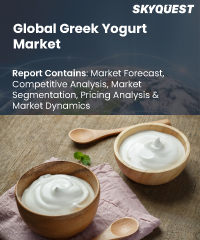
Report ID: SQMIG30I2272

Report ID:
SQMIG30I2272 |
Region:
Global |
Published Date: March, 2024
Pages:
198
|
Tables:
118 |
Figures:
77
Greek Yogurt Market size was valued at USD 33.92 Billion in 2023 and is poised to grow from USD 36.46 Billion in 2024 to USD 65.03 Billion by 2032, growing at a CAGR of 7.50% during the forecast period (2025-2032).
The Global Greek Yogurt Market is a dynamic and thriving industry that has captivated the taste buds of consumers worldwide. Greek yogurt, known for its rich, creamy texture and tangy flavor, has gained immense popularity and has become a staple in the diets of health-conscious individuals. It is a strained yogurt variant that offers numerous health benefits, making it a preferred choice among fitness enthusiasts and those seeking a nutritious snack or breakfast option. The purpose of the Greek yogurt market is to cater to the evolving preferences and demands of consumers who are seeking healthier and indulgent food choices. Greek yogurt stands out from regular yogurt due to its unique manufacturing process, which involves removing the whey, resulting in a thicker and more protein-rich product. This distinctive characteristic has positioned Greek yogurt as a versatile ingredient in a variety of dishes, including desserts, smoothies, dips, and dressings. The market serves the purpose of providing consumers with a nutritious and delicious alternative to traditional yogurt and other snack options. The Greek yogurt market is driven by several factors that contribute to its steady growth. Firstly, the rising health consciousness among consumers, coupled with an increasing focus on protein intake, has propelled the demand for Greek yogurt. With its higher protein content compared to regular yogurt, Greek yogurt aligns with the growing desire for healthier food choices. Additionally, the versatility of Greek yogurt in various culinary end users has boosted its demand in both households and the food service industry.
However, the market does face certain restraints. One of the main challenges is the premium pricing of Greek yogurt compared to regular yogurt, which may limit its accessibility for price-sensitive consumers. Furthermore, the production process of Greek yogurt requires more milk, leading to higher manufacturing costs. These factors can pose a hindrance to market growth, particularly in price-sensitive regions or during economic downturns. The Greek yogurt market is witnessing key trends that are shaping its future trajectory. Firstly, there is a growing emphasis on product innovation and diversification, with manufacturers introducing a wide range of food flavors, blends, and packaging formats to cater to varying consumer preferences. Additionally, there is a rising demand for Greek yogurt with lower sugar content and enhanced functional properties, such as probiotics and added nutrients. Opportunities in the market are abundant, driven by the increasing penetration of Greek yogurt in emerging economies and untapped markets. As awareness regarding the health benefits of Greek yogurt spreads, manufacturers have an opportunity to tap into new consumer segments and expand their market presence. Furthermore, collaborations and partnerships with retailers, food service providers, and health-conscious influencers can further boost market growth by increasing product visibility and reaching a wider audience.
Our industry expert will work with you to provide you with customized data in a short amount of time.
REQUEST FREE CUSTOMIZATIONWant to customize this report? This report can be personalized according to your needs. Our analysts and industry experts will work directly with you to understand your requirements and provide you with customized data in a short amount of time. We offer $1000 worth of FREE customization at the time of purchase.

Report ID: SQMIG30I2272